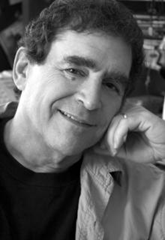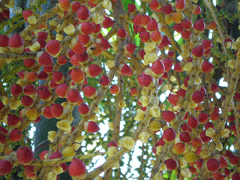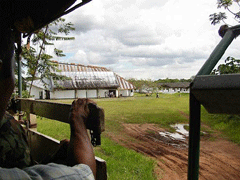A Village to Reinvent the World
Air Date: Week of October 17, 2008

Four decades ago, a group of South Americans joined together to create an ecological utopia. The village, called Gaviotas, was based on the idea that they could use limited resources to create a sustainable community. In 1998, journalist Alan Weisman wrote a book about the Colombian experiment. It’s called “Gaviotas: A Village to Reinvent the World” and it’s just been updated for a 10th anniversary edition. Weisman talks with host Steve Curwood about his recent visit to Gaviotas and how the community is faring.
Transcript
CURWOOD: Back in the 1970s, a group of South American scientists and engineers began work on a sustainable community in Colombia’s arid war-torn eastern plains – grasslands known as “Los Llanos.”
They named their ecovillage Gaviotas, and hoped it might serve as a model for sustainable development in the tropics. The founders experimented with agriculture and developed a host of affordable technologies that could be exported to other tropical communities.
In 1994, science journalist Alan Weisman produced a documentary on the project that ran on National Public Radio programs, including this one. In 1998 he wrote the book, “Gaviotas, a Village to Reinvent the World.”

Author Alan Weisman (Courtesy of Chelsea Green)
WEISMAN: By the moonlight I can see it – a forest rising up from this formerly empty plain. Twelve years ago researchers discovered that pines from Honduras thrive in these thin soils. Since then, Gaviotas has planted more than a million. Instead of cutting them for timber, they’re selling the renewable sap for making paint and turpentine. They don’t earn as much money this way, but Gonzalo reminds me, that’s not the point.
[GONZALO SPEAKING IN SPANISH]
TRANSLATOR: We believe austerity is a better path to happiness and to man’s comfort. In Colombia’s oil camps, what have they gotten? Prostitution and alcoholism, because salaries are too high. Then the oil is gone. What’s left is misery.
[GONZALO SPEAKING IN SPANISH]
TRANSLATOR: Meanwhile we plant trees so the atmosphere won’t disappear.
[GONZALO SPEAKING IN SPANISH]
WEISMAN: Although ecologists originally questioned bringing a Central American species into Colombia’s Llanos, something amazing has happened.

Caribbean Pine trees are tapped for resin. (Courtesy of Hollister Knowlton)
[CRICKET SOUNDS]
WEISMAN: In the moist understory of the Gaviotas Forest, dormant seeds of native trees probably not seen in Los Llanos in millennia are sprouting. Biologists have now counted at least forty species, which are sheltered by Caribbean Pines. Over the coming decades, Gaviotas will let these new native trees choke out the pines and return the Llanos to what many believe was their primeval state, an extension of the Amazon. Already the population of deer and anteaters is growing.
[CRICKET SOUNDS]
CURWOOD: So more than a decade ago people were hoping that one day, native species would be able to outcompete those Honduran pines they had planted. I know it’s only been a little more than ten years, but how does that forest look today?
WEISMAN: I was totally amazed. You stand right next to it and you really have to squint hard to realize that there are rows of pines between these really tall jacarondas and ficus and monkey pods and laurels and curary, and all these other beautiful trees that are growing there. Well, it turns out that the pine trees, growing among these natural species, are still producing plenty of resin. They’re growing really tall and really well themselves, so Gaviotas believes that this is a great example that polyculture is a much better way to go than monoculture. It’s ultimately healthier, even for the crop that you’re growing.
CURWOOD: I understand that the Gaviotans have introduced another non-native species of tree, the African Palm. Can you tell me about that?
WEISMAN: The Gaviotans are trying to do something that in other parts of the world is controversial – grow a non-native species, African Palm, which has a fruit that produces a lot of oil, and to turn it into biodiesel. The reason it’s controversial elsewhere is that native forests are being scraped away to produce palm oil, or farm crops are being replaced by energy crops. What Gaviotas is trying to do is the same thing that they have done with their pine resin plantation – is plant trees where nothing else is particularly growing anyhow. If they can, they’re going to produce enough biodiesel to fuel their own vehicles. There’s also a project proposed that the Colombian government is very interested in, to plant enough palm oil trees that would make the entire country of Colombia self-sufficient in biodiesel production. If this works, Gaviotas believes that treeless savannas all over the world could be the place to grow energy crops sustainably.

Fruit from oil palm trees can be converted to biodiesel. (Photo: Tansra Kaur)
CURWOOD: Now, one of the most fascinating aspects of the story is, in fact, all these inventions or adaptations of inventions really. In a way there’s just a whole series of, what I would call appropriate technologies for a less developed world. In fact, let’s listen to another piece of your original documentary – a point at which a guide in Gaviotas is showing you some of the various technologies that they have developed.
[CRICKETS]
WEISMAN: For years, Gaviotas has been a nonprofit foundation, a model for the United Nations development program. But to finance themselves, the Gaviotans must also market their technology. That isn’t so easy, Gonzalo says, since Gaviotas refuses to patent their inventions, preferring to share them.
[SOUND OF MACHINERY]
WEISMAN: The factory at Gaviotas employs many of the hundred and thirty Gaviotas residents, as well as people from surrounding communities. Here they produce the innovative devices that Gaviotas uses and sells, such as the windmills I saw on the way here.
[GONZALO SPEAKING IN SPANISH]
TRANSLATOR: We study 56 different windmills from all over the world until we got to this version.
WEISMAN: Its design has since been copied from Central America to Chile.
[GONZALO SPEAKING IN SPANISH]
WEISMAN: In one corner Gonzalo shows me stacks of solar panels that can heat water with diffuse sun light in rainy climates. Then he leads me across the factory floor to a machine resembling a stationary bicycle which uses pedal power to strip stalks of Cassava.
[GONZALO SPEAKING IN SPANISH AND MACHINE SOUNDS]
WEISMAN: Gonzalo and factory foreman Juan Navoa next take me outside to what they call Gaviotas’ most significant achievement. All I see is a yellow pump handle attached to a covered well.
[GONZALO SPEAKING IN SPANISH AND WATER FLOWING]
TRANSLATOR: This double action pump taps water six times deeper than normal models. Instead of raising and lowering the heavy piston inside a pipe, this one leaves the piston stationary and lifts the pipe made of plastic tubing.
[SOUND OF PUMPING AND WATER FLOWING]
WEISMAN: I try it.
[MORE PUMPING AND WATER FLOWING]
WEISMAN: It’s so light any child could do it. This simple, inexpensive pump has revolutionized rural life across Colombia for people who used to haul their water in buckets from muddy tropical rivers. But Gonzalo has something even more imaginative to show me.
[WOMEN AND CHILDREN SINGING IN SPANISH]
WEISMAN: When we arrive at the open air Gaviotas preschool children are on the playground.
[MORE SINGING, SQUEAKING OF SEESAW]
WEISMAN: Their seesaw is actually a pump in disguise. As they rise and descend water gushes from a vertical pipe into an open cement tank.
[SOUND OF FLOWING WATER AND SQUEAKING OF SEESAW]
WEISMAN: Over the years, Gaviotas technicians have installed these in thousands of schoolyards, using kid power to provide villages with clean water.
[TEACHER AND PRESCHOOLERS “BUENOS DIAS”]
CURWOOD: Tell me about the water in this region of Gaviotas.
WEISMAN: Much of the water in the area, when you get down to where those pumps are going, is actually artesian water. It’s coming down from the Andes, it’s seeping under this vast alluvial sandy field. It’s quite filtered, and they realized that there was money to be made if they bottled their incredibly pure, sweet water and sold it in the cities, which is what they are doing.
CURWOOD: So tell me a bit about their water bottling business and some of the engineering that they have in that.
WEISMAN: As always, the Gaviotans are never satisfied with the conventional way of doing things. And they realized that one of the problems was when you ship water, usually in cylindrical plastic bottles, and it takes up a lot of space. Could they stack ‘em even tighter? So somebody was looking one day at a kid playing with Lego blocks and realized: wow, if we put some indentation on one side of the bottle and put some bumps on the other side they could all fit together and they could stack much more tightly. That turned out to be a boon to stores to put these things on shelves and kids were saving the bottles – they’re now called “Legos de los pobres”, poor kids’ Legos, and then Gaviotas realized: well, you know we could also recycle these things by filling them with sand and using them as building blocks.
CURWOOD: You know that’s great Alan, but what concern is there about depleting their ground water if they, well, sell off too much of it.

The Gaviotas community center where Gaviotans gather for meals. (Courtesy of Hollister Knowlton)
CURWOOD: Now the hope for Gaviotas was always to develop technologies that are appropriate to the tropics and serve as the model for other communities around the world. So how big of an impact has Gaviotas had on the region, and, for that matter, what kind of effect has it had around the world? Where else are people adopting the ideas out of Gaviotas?
WEISMAN: Gaviotas windmills and pumps can be found from Chile to Mexico. Gaviotas did a very good job of outreach in Colombia. There are many rural areas, in fact I can’t think of many I’ve ever traveled into that I didn’t see a Gaviotas implement or two. I was once in a Payas Indian village in southern Colombia where the installation of Gaviotas pumps immediately cured cholera. There are people in various parts of Colombia that are very grateful to Gaviotas.
CURWOOD: Alan Weisman’s book “Gaviotas: A Village to Reinvent the World” was just published in a tenth anniversary edition with an update. Alan Weisman, thanks so much for taking this time.
WEISMAN: It’s been a pleasure.
CURWOOD: And you can find a complete version of Alan Weisman's original documentary about Gaviotas on our website, loe.org.
[MUSIC: Jerry Garcia & David Grissman “Grateful Dawg” from The Grateful Dawg Soundtrack (Acoustic Disc 2001)]
Links
To hear the original Gaviotas story, click here
Living on Earth wants to hear from you!
Living on Earth
62 Calef Highway, Suite 212
Lee, NH 03861
Telephone: 617-287-4121
E-mail: comments@loe.org
Newsletter [Click here]
Donate to Living on Earth!
Living on Earth is an independent media program and relies entirely on contributions from listeners and institutions supporting public service. Please donate now to preserve an independent environmental voice.
NewsletterLiving on Earth offers a weekly delivery of the show's rundown to your mailbox. Sign up for our newsletter today!
 Sailors For The Sea: Be the change you want to sea.
Sailors For The Sea: Be the change you want to sea.
 The Grantham Foundation for the Protection of the Environment: Committed to protecting and improving the health of the global environment.
The Grantham Foundation for the Protection of the Environment: Committed to protecting and improving the health of the global environment.
 Contribute to Living on Earth and receive, as our gift to you, an archival print of one of Mark Seth Lender's extraordinary wildlife photographs. Follow the link to see Mark's current collection of photographs.
Contribute to Living on Earth and receive, as our gift to you, an archival print of one of Mark Seth Lender's extraordinary wildlife photographs. Follow the link to see Mark's current collection of photographs.
 Buy a signed copy of Mark Seth Lender's book Smeagull the Seagull & support Living on Earth
Buy a signed copy of Mark Seth Lender's book Smeagull the Seagull & support Living on Earth

